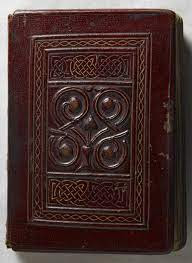He not only made bishops out of some of his close friends, but also made friends out of bishops and priests who were welcome at royal feasts and who were invited into the assemblies where he heard disputes and made decrees.
Æthelstan was a great collector of holy relics, and showed great respect to shrines. When he invaded Scotland in 934, he took along 18 bishops. When he reached the market town of Chester-le-Street, he paid his respects to the shrine of St. Cuthbert, presenting gifts including a stole and maniple for use of the priests who maintained the shrine. (This was before Cuthbert's final resting place at Durham Cathedral.)
His interest in relics was described as þæt he mid þam gewytendlicum madmum, þa unateoridenlican madmas begitan sceolde, Old English for "that he should use his ‘transitory treasures’ to obtain ‘everlasting ones'." The idea was that venerating and preserving these holy relics would help him get into Heaven, so he sent men out to find them. Keepers of shrines also sent him some.
He donated to churches, but did not found as many as the later legends suggest. His reputation in this area seems to have exceeded the evidence that some churches were founded during his reign as they believe in their local histories. Æthelstan also made donations to churches outside of England. When a delegation went to the court of Holy Roman Emperor Otto I with two of Æthelstan's half-sisters, so that Otto could pick one as a wife (he chose the 19-year-old Eadgyth over the older Eadgifu), the priest accompanying the delegation continued throughout Germany, visiting monasteries and presenting gifts from Æthelstan. In exchange they were asked to pray for the king.
Unfortunately, Æthelstan's kingship did not last very long after he united England, and I'll go into his final days tomorrow.











